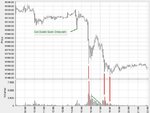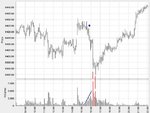dbphoenix
Guest Author
- Messages
- 6,954
- Likes
- 1,266
ljyoung said:A general question for VSA-volk.
Can anyone say from either personal experience or on the basis of something they've read or been taught what the volume relationship is (if indeed one exists) between the "stopping volume" bar and the "bottom" bar it is associated with? My preliminary impression is that the volume at the bottom is less than the stopping volume with the corollary being that if the putative bottom does not have a lesser volume then it is not the bottom but rather a new stopping volume bar.
TIA.
lj
Since no one has answered your question . . .
If by "stopping volume" bar you mean the selling or buying climax, then, yes, the volume at the eventual price bottom will be less. However, the selling climax and the bottom may coincide. If you'll look in the Tops 'n Bottoms chapter in the book you bought from me, you'll note that the selling climax and bottom bar were the same in the '98 correction bottom. However, the selling climax and bottom "bar" were separated by 10 weeks in '02. (I'm sure there are other examples in the Practicum chapter, but I don't have time to look through it right now; use Find and "climax".)
In other words, the selling climax serves to slam on the brakes and may also be the first sign of accumulation, depending on the instrument. But the road may be slick, and slamming on the brakes doesn't mean stopping on a dime, much less turning on one. Sometimes the brakes are tapped, as in '01 and '02. But volume -- or trading activity -- does not alone tell the story; it is necessary to evaluate price and volume together.
Db



